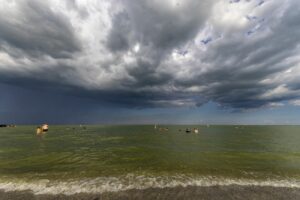Even though summer is coming to an end we still have plenty of hot news articles in News to Us. Read below for the latest on the Tribar hexavalent chromium spill investigation, and improvements to Huron River metroparks. Also featured are two articles on Lake Erie-related water quality, including the launch of a basin-wide citizen science monitoring collaborative and an investigation of algal bloom reduction efforts.
Weeks after Tribar chromium waste spill, many questions remain
Over a month after the hexavalent chromium spill from Tribar Technologies to the Wixom wastewater treatment plant, multiple investigations continue into the facility’s operations, decision-making, notification systems, and personnel. Both the Federal Bureau of Investigation (FBI) and the Michigan Department of Environment, Great Lakes and Energy (EGLE) are collecting information and determining appropriate penalties such as administrative orders, fines, and civil litigation.
Metroparks to improve access to paddling along Huron River
The Huron-Clinton Metroparks received $500,000 in grant funding from the Michigan Department of Natural Resources Trust Fund to support improved accessibility and paddler experience along the Huron River Water Trail. The projects at Hudson Mills and Dexter-Huron Metroparks incorporate universal design principles to improve accessibility for all visitors. Started earlier this year, the Hudson Mills project has a few finishing touches but is currently available for use. The Dexter-Huron project will break ground in 2023 and include an expanded parking lot and playground.

Danger looms where toxic algae blooms
As the first of a six-part series from Circle of Blue, this articles explores the causes, impacts, and solutions to harmful algal blooms in the Great Lakes, specifically the western Lake Erie basin. The piece investigates federal, state, and local efforts to mitigate non-point source nutrient discharges from agriculture and the challenges towards progress. Check out HRWC’s recent Huron River Report newsletter for information on efforts to reduce phosphorus runoff from farms with the Huron River watershed.
Lake Erie communities standardize volunteer-collected data
A new collaboration of local water quality monitoring programs, called the Lake Erie Volunteer Science Network (LEVSN), aims to standardize volunteer-collected data to fill critical information gaps and improve data credibility. HRWC and 15 other participating groups are working together through LEVSN to adopt new water monitoring technologies and standards to enable high-quality data collection and regional collaboration.



